So, do tents come with stakes? The easy answer is YES!
The majority of commercial tents will come with a set of stakes you can use to secure your tent structure to the ground.
However, the set of stakes included in the tent set usually tend to be cheaper, less secure, and more likely to bend and break on rough ground.
That being said, while most tents will come with a set of stakes, the real question is “do you actually want to use them?”
Many campers will ditch the included stakes after a few nights on the trail and buy their own preferred set.
Table of Contents
ToggleShould I Upgrade My Tent Stakes?
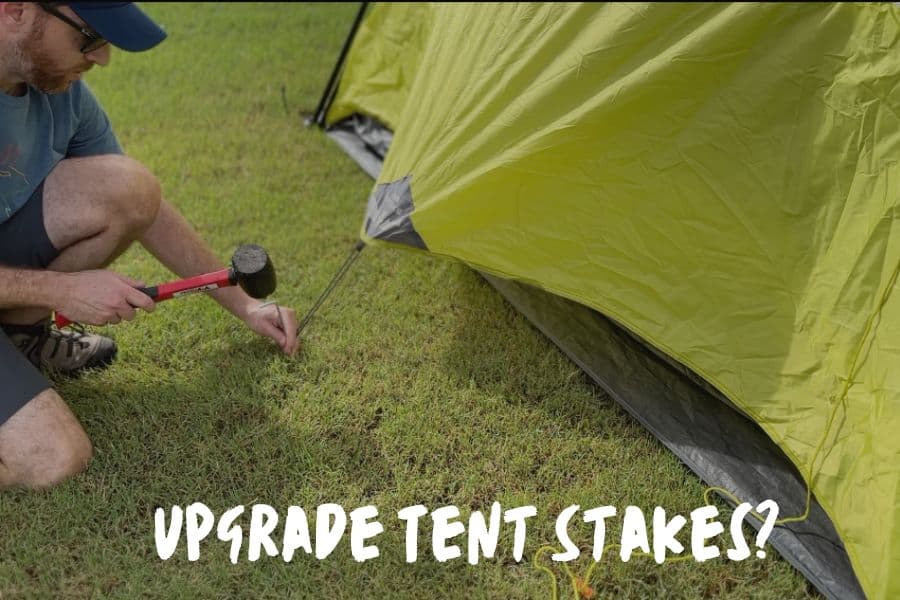
The tent stakes that are included in the original tent packaging will work best on soft and even ground in moderate conditions.
Unless you have bought a premium tent that comes with premium stakes, you will definitely want to upgrade your tent stakes.
The main reason we recommend getting your own set of stakes is because tent stakes are fundamental to keeping your tent secure.
Tent stakes that you buy separately can be more durable, lighter in weight, and will keep your tent secured to the ground more effectively.
If your stakes are cheap (like many of the manufacturer stakes), they will be prone to bending and it can compromise your overall tent structure.
And, when your tent structure is compromised, it can affect your tent’s ability to keep you protected from the elements.
Therefore, if you are planning to set up camp on rocky, uneven, or hard ground – or in cold, windy, or snowy conditions – it’s best to opt for a set of your own stakes.
Unless you have bought a premium tent, it is unlikely that your stakes will work out of the box. Period.
Additionally, tougher stakes will also work in milder conditions. So, one set of high-quality stakes can serve you well for all camping trips.
How Many Stakes Do Tents Need?
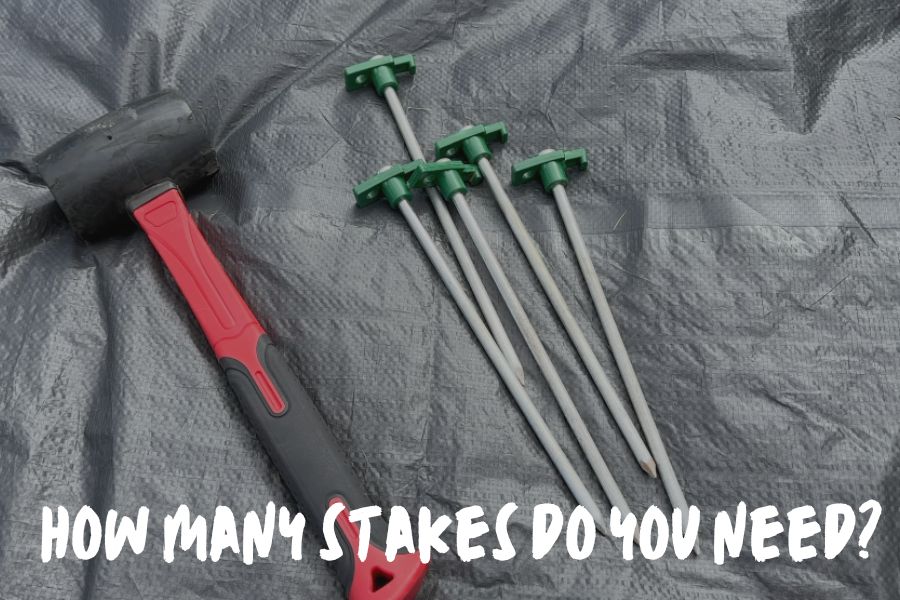
Most tents will include a set of stakes in the original packaging that’s proportionate with the size of tent – or the number of people that can fit inside.
The table below will cover how many stakes usually come with each tent.
If you’re planning on purchasing your own set of stakes, it’s important to purchase enough to effectively secure your tent based on its size.
| Tent Size | 1-person | 2-Person | 3-Person | 4-person | 6-person | 8+ person |
| # of Stakes Required | 6–8 | 7–9 | 8–10 | 10–12 | 10–14 | 12–16 |
Different Types Of Tent Stakes
Shepherd Hook Stakes
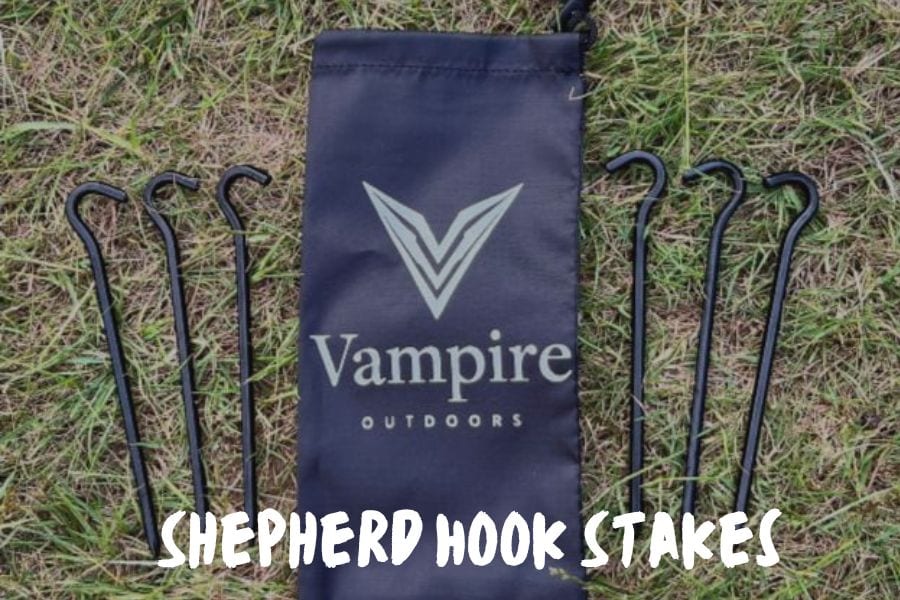
When you think of a classic tent stake, you’re thinking of a shepherd hook stake. This type of stake is the design most likely to be included in the bag when you purchase your tent.
While these are everywhere, they are generally cheaper and less effective than the other kinds of stakes. Shepherd hooks work best on soft and even ground and in milder conditions.
However, they can fall short on rocky, uneven, or cold ground. Because of their tendency to bend and spin in the ground, they are not as effective as other types of stakes in keeping your tent secure during high winds.
If you find these in your tent bag, feel free to try them out on a campout in milder conditions.
In general, you will find you’ll need to replace them more frequently than other, more durable models.
And, if you’re headed into more intense conditions, we recommend you look for another set of stakes.
In terms of weight, shepherd hook stakes are around 14 g, which is one of the heavier options on our list.
V-shaped Stakes
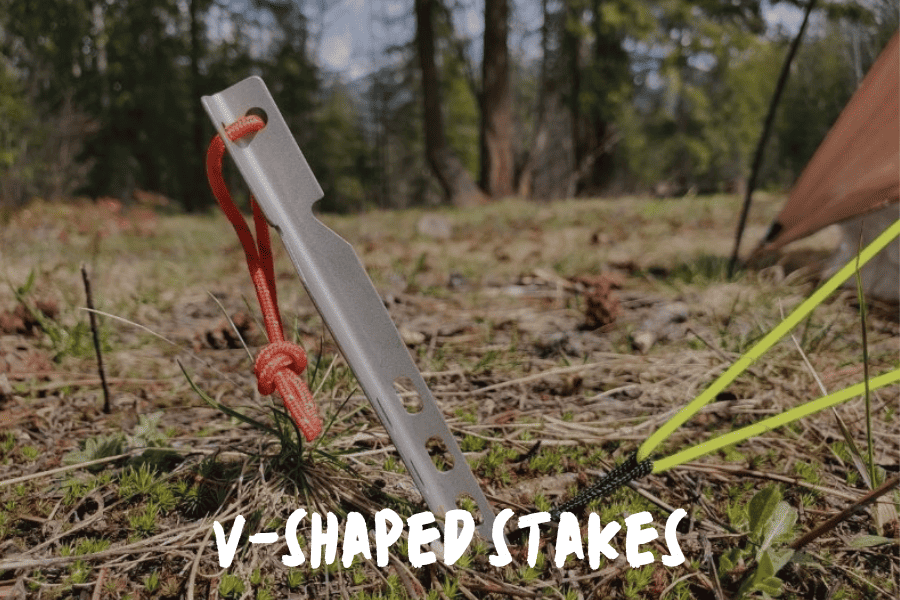
These stakes are a great upgrade from shepherd hook stakes in durability, stability, and weight.
Because these stakes resemble long, narrow shovels, they are easy to push into the ground. Their high surface areas thrive in uneven ground.
They will keep your tent safe and secure throughout many types of inclement weather.
With a weight that’s roughly around 12-13 g, these are a great option if you’re trying to conserve weight in your pack.
Y-shaped Stakes
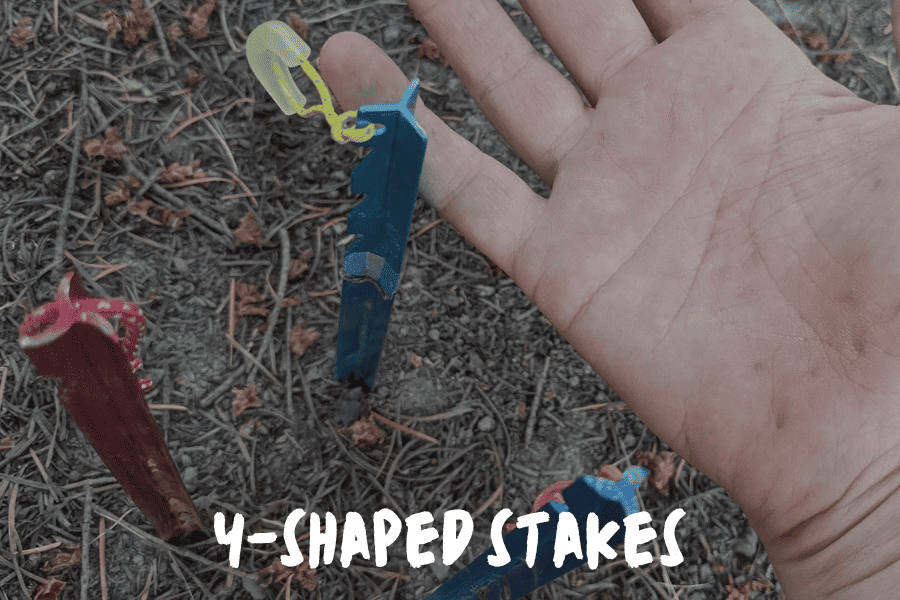
Y-shaped stakes get their name from the shape of their aluminum, 3-pronged body. They can also be referred to as groundhog stakes.
These are known to hold up well in tough ground and weather conditions.
Their shape provides several points of contact between the stake and the ground. This means they are unlikely to spin in the ground once put in place and will keep your tent secure.
Coming in anywhere between 9-15 g, these stakes are also a great lightweight option.
Cyclone & Spiral Stakes
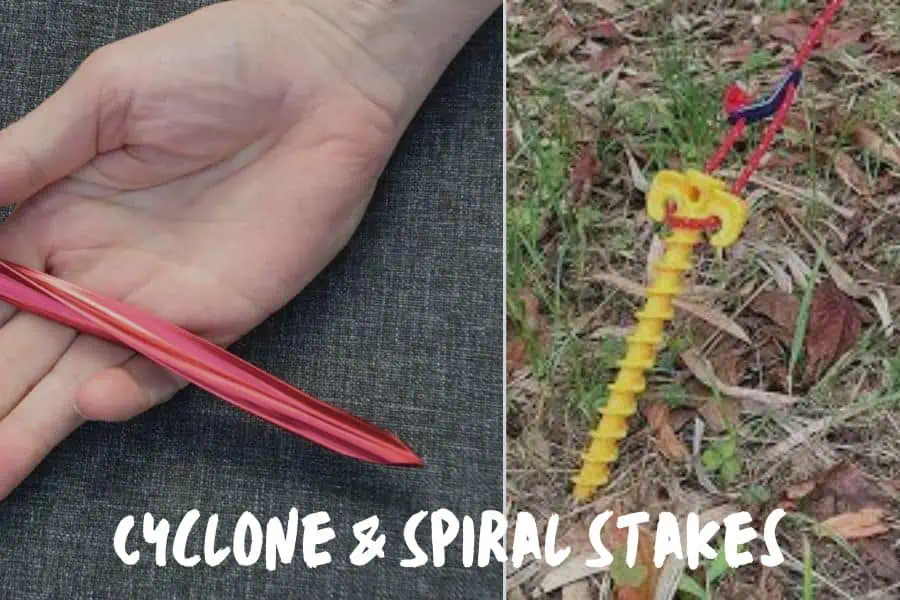
Cyclone stakes resemble a Y-shaped stake that has been twisted into a narrow spiral. The twisting creates several contact points with the ground, which increases the security of your tent.
These stakes are extremely durable and will work effectively in even the roughest ground and weather conditions.
Their downside? Cyclone and spiral stakes are known to be slightly heavier than other types of stakes, coming in at around 34 g each.
However, some campers find they will happily carry the weight if they’re in need of the extra security these stakes provide.
Nail Stakes
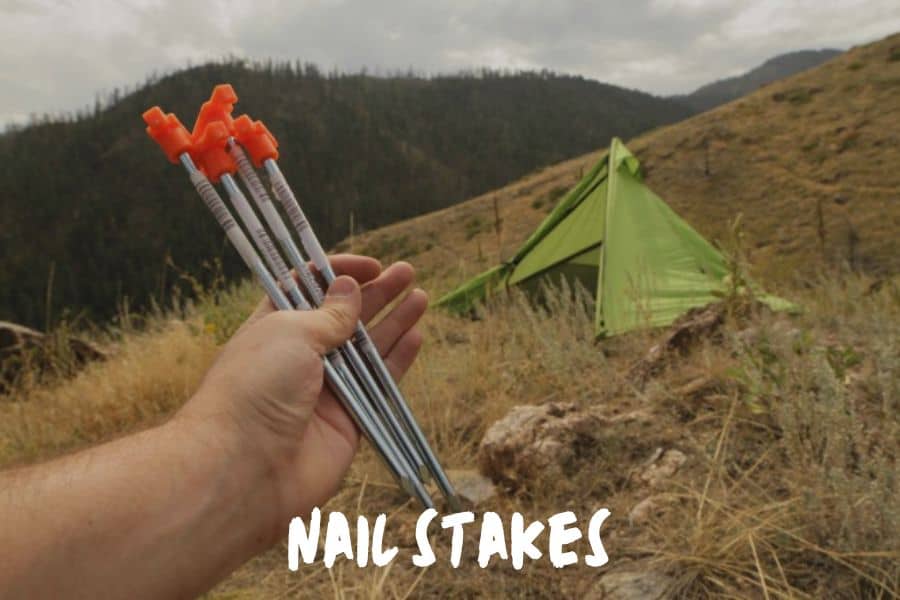
Nail stakes, as their name would suggest, look like enlarged nails. While this type of stake is lightweight and durable, they are not as effective as other types.
Their main drawback comes from their top. While other forms have a notch or hook to secure the guyline, nail stakes do not have anything to hold the guyline in place.
This means nail stakes risk spinning in the ground and losing grip of the guyline in high wind conditions.
This can compromise the overall structure of your tent and its ability to protect you from the elements.
However, at 8-12 g, this type of stake is competitively lightweight.
How To Use Tent Stakes
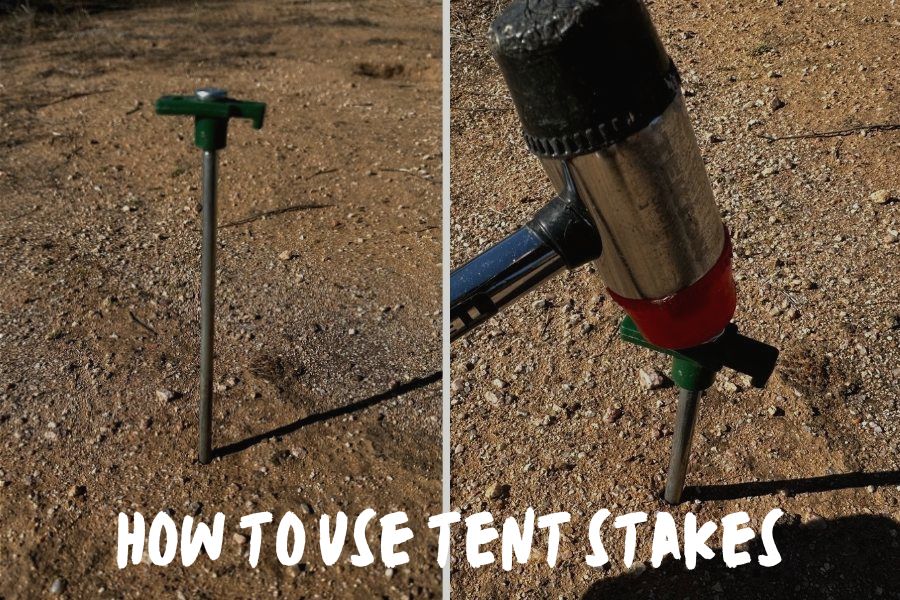
Once you’re familiar with using stakes, the process of staking your tent will become intuitive.
While the general process is fairly similar, the ground conditions you encounter can affect how you complete the process.
The following sections will cover those discrepancies based on ground conditions.
Dirt, Grass, Or Soft Soil
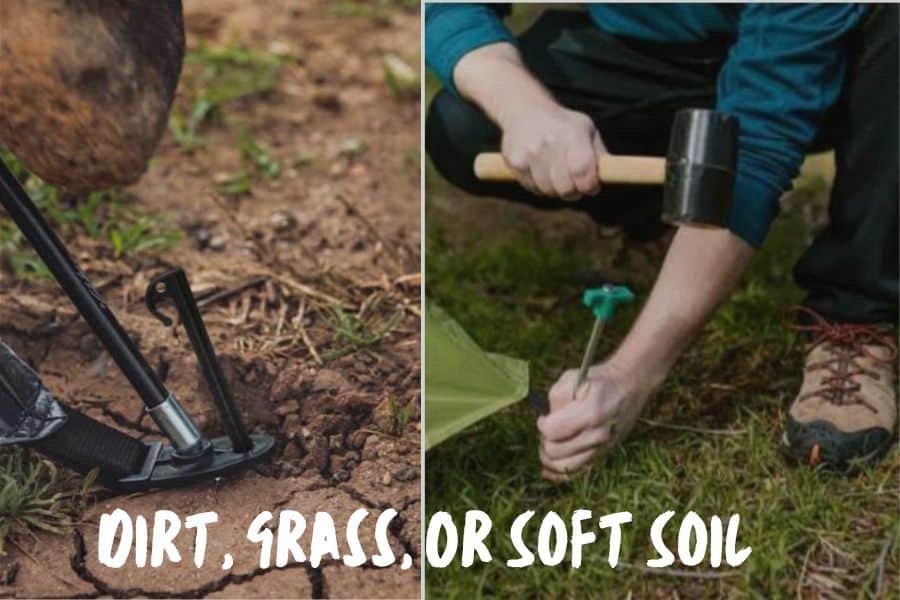
Dirt and grass, otherwise known as “soft soil,” is one of the most classic tent staking scenarios you can find yourself in.
First, secure the guyline to the stake. Once the guyline is taut, bring the stake down to the ground and insert it into the ground, angled away from the base of the tent.
The main obstacle you can encounter when staking in “soft soils” is that the stake can slip out of the soft ground.
Because of this, we recommend pressing the stake into the ground with your hand, a rock, or a stake hammer.
However, be careful during this final step! Stomping or slamming down on the stakes with rocks too erratically can bend and damage the stakes.
Since this is the easiest type of soil to stake a tent in, we recommend that this is the only type of terrain you use shepherd hook stakes in. The other models we described above will also work here.
Sand
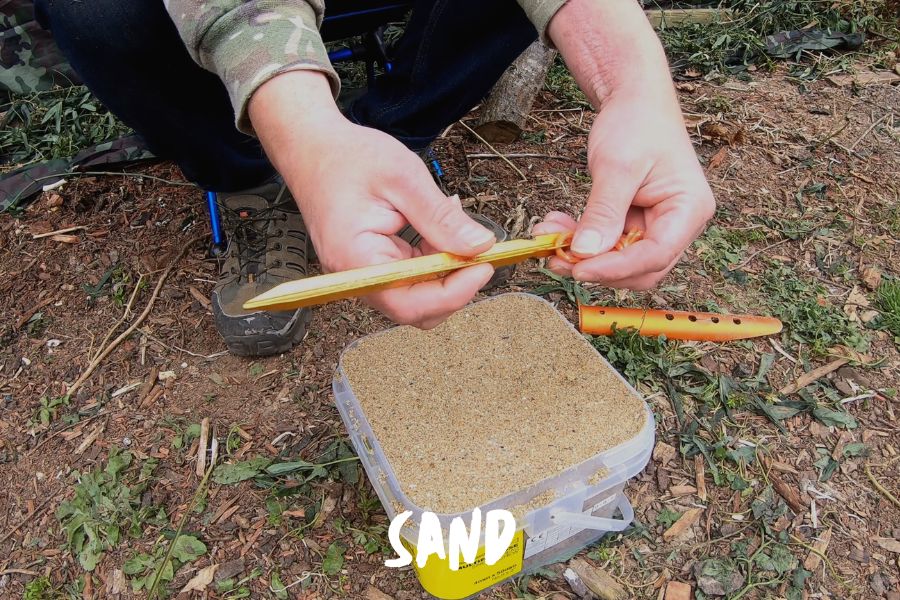
Because sand is always moving under your feet (and tent), it can be extra difficult to stake your tent down in it.
With beach camping, we recommend you get specific sand/snow stakes to ensure your tent is as secure as possible.
Usually, V-shaped stakes or cyclone stakes are best for sandy terrain. They are much larger to give them more surface area, which equals more grip on the moving sand particles.
Also, these stakes sometimes have holes throughout their length, which allow them to have an even better grip.
For V-shaped stakes you’ll push them into the ground, similar to how you would push a stake into soft soil.
If you’re having a hard time with it staying in one place, try digging down with your hands until you reach a layer of wet sand, and try to stake it there.
If you’re using a spiral-shaped stake, you’ll want to twist it into the ground. Sometimes, this can take some physical effort, but it’ll be more than worth it when your tent is super secure in the ground!
Snow & Frozen Ground
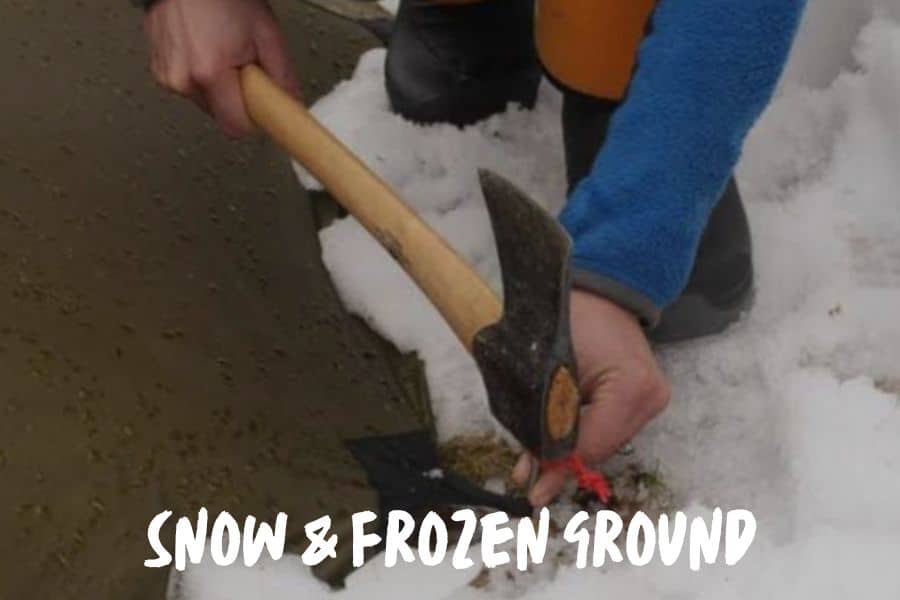
Snow and frozen ground can also present challenging staking scenarios. There are two main techniques to use, depending on if you’re staking into snow or into the frozen ground.
If you’re planning to stake your tent down in the actual snow, you’ll want to start by digging a hole in the snow about a foot or two deep.
Once you have dug the hole, place your snow stake vertically against one of the sides of the hole. This stake should be similar to a sand stake: larger to give it more surface area and ground grip.
When your guylines look tight enough, start filling in the hole until the snow is tightly packed on top of the stake.
If you’re staking your tent into frozen ground, the process will be slightly different.
You can use either a snow-specific stake or a regular heavy-duty stake to secure your tent in frozen ground.
First, you’ll dig until you make contact with the frozen ground.
Then, stake down your tent to the ground with the guyline attached, facing away from the base of the tent structure.
Getting your stake to stay securely in the ground may be a challenge in frozen conditions where the ground is routinely harder.
Many campers will use a stake hammer for this step, ensuring that they can get their stake as far into the ground as they can.
Rocky Ground
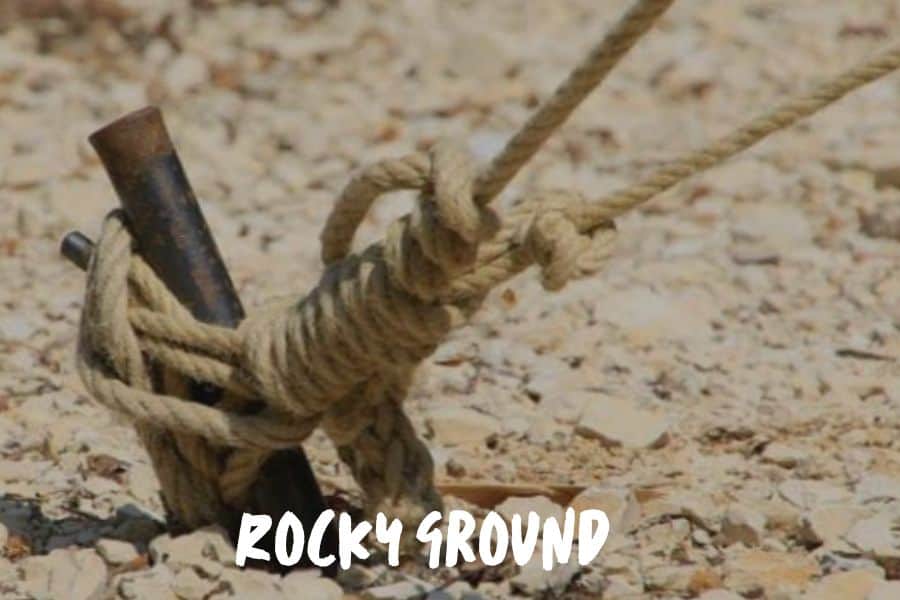
Rocky ground can be tricky to stake your tent down in because there are lots of obstacles (like rocks) in the way of your stakes getting a secure hold.
The first step in any rocky environment is to clear the ground area of any rocks. Not only will this save your back from sleeping on bumpy ground, but it’ll also make it easier to stake down your tent.
When you’re in the process of staking down your tent, don’t try to force your stake down into the ground, especially if you’re facing resistance.
It’s likely that any resistance is caused by a rock in the ground. Forcing the stake further can bend or damage the stake.
If the ground is so rocky that you can’t get a stake into the ground, you can try the “Big Rock, Little Rock” technique.
This technique includes using two different rocks (one big, one little) for each guyline you need to stake down.
Once you’ve tied the guyline around the smaller rock, you place it down on the ground, pulling the guyline taut.
With everything in place, you then place down the big rock just next to the smaller rock to reinforce the structure. Check out the video below to learn more about this process.
FAQs
Do All Tents Require Stakes?
Yes, to keep your tent secure on the ground, you should absolutely be staking every tent you set up.
While this might seem like overkill in milder conditions, it’s better to be safe than sorry.
You never know how the conditions will change while you’re away on a day hike or asleep in the tent!
Making sure your tent is staked down will ensure that your tent is as secure as possible.
How Many Stakes Do I Need For My Tent?
This depends on the size of your tent and how many people it can fit. In general, a 2-person tent will require 7–9 tent stakes to stay secure.
The number will increase from there depending on the size of your tent.
Check out the table above to see more information on the amount of stakes you’ll need for each size of tent.
Can I Use Improvised Items As Tent Stakes?
Yes, but it will affect how effective the item is in keeping your tent secured to the ground.
While it’s preferable to use real stakes, you can use sticks or rocks to keep your guylines taut in a pinch.
It’s always more important to have something securing your tent than to leave your tent unsecured to the ground.
Any item that’s not designed for staking down a tent has the potential to break, move, or stop working while in use.
What If I Lose Some Of My Tent Stakes?
If you lose some of your tent stakes, you can always purchase more! Most tent and outdoors manufacturers sell tent stakes on their own, so you can buy a replacement set if needed.
If you lose some of your stakes while you’re on the trail, you can use sticks or rocks as an impromptu solution.
Although, they will not be nearly as effective in keeping your tent secure.
Are There Specific Stakes For Different Terrains?
Yes! Most of the stakes we’ve covered above will work in the majority of terrains.
However, there are stakes that will work best for when you’re camping in snow or sand.
In general, these stakes are usually larger than classic stakes.
They need to have more surface area and more connection points when in the ground to keep the tent secure.
How Do I Properly Stake Out A Tent?
Take a look at our article for how to stake a tent to read an in-depth example of how to do just this!
You can tell a tent is staked properly when the guylines are taut.
Can I Reuse Tent Stakes For Different Tents?
Absolutely! Most tent stakes are for general use, not tent-specific. If you have a good set of stakes that you like to use, you can likely use it with most tent models.
If you’re setting up camp in sand or snow, you should use stakes that will stay secure in those environments.
Conclusion
Staking your tent is an important step in keeping your belongings and yourself safe and secure throughout your camping trip.
Because of their advantages, if you decide to opt for purchasing your own set of tent stakes you won’t regret it.
Getting them can be a great step in becoming a pro out in the woods!


